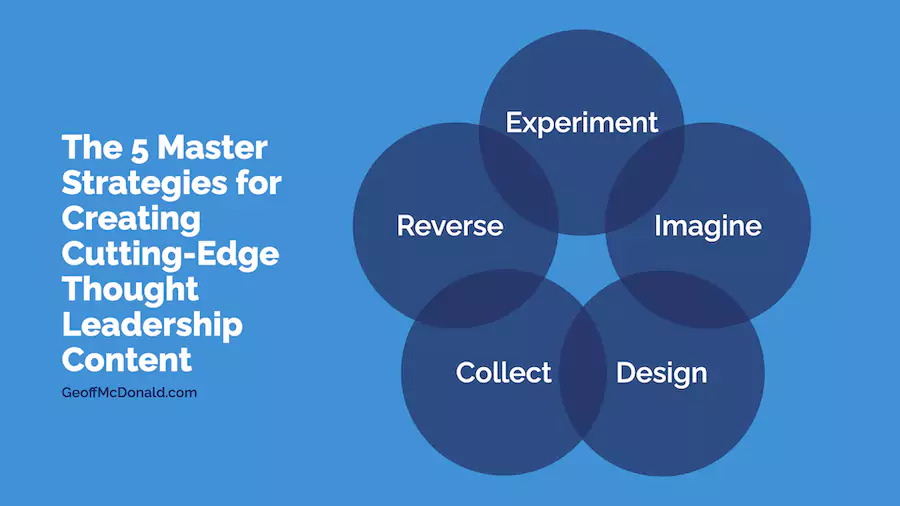The best thought leaders create cutting-edge content. But how do you do this?
We presume the thought leaders with the groundbreaking ideas are simply smarter than the rest of us. That might be true. But it doesn’t tell the whole story. Success leaves clues.
In this post, I’ll show you the five ways that thought leaders create cutting-edge content so you can follow in their footsteps.
Plus, I’ll share five thought leadership examples, each with a TED talk video to watch so you can hear how each person created their cutting-edge content. It’s a thought leadership masterclass.
1 Experiment – Test what works
Kary Mullis (1944-2019) won the Nobel Prize in 1993 for Chemistry.
In his TED talk, Kary tells the story of how he started making rockets in the backyard as a kid (12:23). His mission was to turn a frog into an astronaut.
He found a small booklet that gave him some clues and then he just started doing experiments to see what would happen. After about six months he finally figured it all out and he was able to shoot frogs into space. Or at least high above the ground.
And that’s a great example of experimenting. You do things, you observe what happens, write down a few notes and you build up a theory of how it all works.
This is the first way to create cutting-edge thought leadership content. Go and do some experiments and build up a theory of how it all works.
It’s the classic way of how to do science.
One way thought leaders can do experiments is in their everyday work both personally and with their clients. Now, I’m not suggesting that you take big risks with your clients and blow up their business. But if you know that a general principle works, then you can test for variations that may work better.
2 Reverse – Model Success
Legend has it that Michael Dell, founder of Dell Computers, was given an Apple II computer for his 16th birthday. And to his parents’ horror, he immediately pulled it apart to see how it worked.
This is an example of our second way to create cutting-edge thought leadership content – reverse engineering.
The process begins with a finished working example created by someone else. You pull it apart to find out how it works. This is easy to imagine for a mechanical thing, but it can also be a conceptual or data-driven process.
Once you have worked how a thing works, you then have the building blocks to create something new. The goal is to look for the hidden structure.
Amy Webb tells the hilarious story of how she was looking for a husband. She started with the challenge: How do I find Mr Right?
She did some sums to work out that online dating was her best chance. But her early attempts at finding a match online didn’t turn out that well. She started to reverse engineer the process. Along the way, she created 72 new data points and even came up with her own scoring system. You’ll have to watch to find out if she found her man, or not.
To create cutting-edge thought leadership content, find something that works, reverse engineer it to find out how it works and then make it better.
3 Imagine – Build Scenarios
The third way to create cutting-edge thought leadership content is through a thought experiment.
And your immediate reaction to this might be to think you have to take LSD or some other mind-bending drug.
But the reality is you do this all the time. And I’ll bet you’re doing it right now. You’re sitting there reading this post and wondering, ‘Should I continue reading this or should I go and do something else?’
And to answer that question you create possible scenarios of what might happen. That’s a thought experiment.
In thought leadership, a thought experiment asks, ‘What if? If this situation were to happen, what action should I take?’
Sci-Fi writers like Charlie Jane Anders are great examples. They take a piece of current or possible technology, and they imagine scenarios for how it may impact us in the future.
Charlie Jane’s TED talk starts with the example of her writing a story where governments start using drones to kill people. When she started writing about it, this was simply an idea. And by the time she finished writing about it was already happening.
She also talks about a thought experiment about the future of the city. What could that look like? And how might it change the way we live.
And her process bounces back and forth between imagination and research.
You can use a thought experiment to create future scenarios: What is the future of your industry?
4 Collect – Gather evidence
What is your favourite TV crime show? If you’re a fan of crime shows or murder mysteries, then you’ll be familiar with the fourth way to create cutting-edge thought leadership content.
The typical crime show follows a familiar pattern. It begins with a crime being committed – someone is killed, something is stolen, or someone is hurt. Then the detectives turn up and start gathering evidence until they can identify who caused the crime and how they did it.
This is the role of the collector. And this is how I created the five master strategies in this video – I collected a bunch of examples as clues until I could point to some principles that apply in many cases.
Kenneth Lacovara opens his TED talk with the fabulous question, ‘How do you find a dinosaur?’
He then runs us through the formula that paleontologists use. That formula is all about finding the right rocks of the right age for the type of dinosaur you’re looking for. Then you go to the area on planet earth where those rocks are found. If you see some fossil evidence sticking out of the ground due to erosion you start digging.
Kenneth used this formula to find a sauropod – a new species of dinosaur as big as a two-storey house and as heavy as a jumbo jet. To unearth a dinosaur that big you do what all collectors do – you find lots of small pieces until you make one big piece.
To be a thought-leading collector, start gathering your evidence and keep going until a pattern is formed and you can solve your mystery.
5 Design – Create a Solution
The fifth way to create cutting-edge thought leadership content is through design.
And here’s another hilarious TED Talk example from Thomas Thwaites.
Thomas starts with the question: How can I build a toaster from scratch?
This might seem like a strange thing to do when you realise his first step was to go down to the local store and buy a toaster for about five dollars so he could pull it apart (reverse engineering) to see what components are in a toaster. Anyway, I’m up for a good creative project as much as anyone so I admire Thomas’ quest.
As a former architect, I’m familiar with the design process. At a simple level, there are two parts.
- You first must gather all the components. In Thomas’ example, he went out to make the components himself from scratch – which was a crazy adventure. He even went to a mine to get his own iron ore to make the steel.
- Then he had to combine all the components into a viable solution.
While I wouldn’t be cooking my bread in Thomas’ toaster, it’s a great example of how you can design your cutting-edge thought leadership content.
How Thought Leaders use these strategies
There you have it – five master strategies to create cutting-edge content as a thought leader.
One more thing… If you watched the TED talk videos along the way you might have noticed that these are not five separate strategies.
In Amy Webb’s example, she uses four of these strategies. Her major approach is reverse engineering. But you can also see that she collected data, she went on dates as experiments (to collect that data) and she also came up with a finished design or solution.
This suggests that the strategies overlap, and you’ll likely use more than one to create your cutting-edge thought leadership content.
More on How to Create Cutting-Edge Thought Leadership Content
This is the fourth video in a four-part series on how to go from a beginner to an elite performer. We’ve applied it to Thought Leadership and Content Creation – but you can apply the same principles to any field. Here are the other posts in this series:
- The four steps for how to become a Thought leader
- Content Creation for Beginners – Five Big Mistakes to Avoid
- Content Strategy Secrets – From Beginner to Expert
Add a comment below – which of these five master strategies do you already use in your work?



